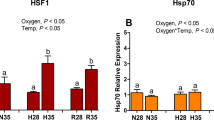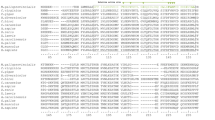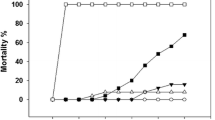Abstract
In aquatic environments, hypoxia and oxygen-deficient areas are increasing worldwide. Transitions in oxygen levels can influence the production of reactive oxygen species (ROS), eventually leading to oxidative stress. The transcriptional response of oxidative stress biomarkers was evaluated by qPCR in gill tissue from Mytilus galloprovincialis experimentally subjected to 48-h air exposure followed by 48-h re-oxygenation, as compared to normoxic control mussels. Superoxide dismutases (CuZnsod and Mnsod), catalase (cat), and glutathione S-transferase (gst) were over-expressed early after 8-h air exposure and returned to normoxic levels during re-oxygenation. Moreover, the mRNAs and protein expression patterns of heat shock proteins (HSP70 and HSP90) and metallothioneins (MT-10 and MT-20) were modulated by oxygen availability with increased levels during re-oxygenation suggesting the participation of these cytoprotective mechanisms in the physiological oxidative stress response when oxygen concentration was restored. Overall, the observed modulation of the oxidative stress-related and general stress genes indicates that M. galloprovincialis responds to changes in oxygen availability enhancing the antioxidant potential under low oxygen conditions for dealing with the oxidative burst during future re-oxygenation. The present investigation brings further insights in understanding how intertidal molluscs cope with short-term oxygen variations and gives useful biomarkers for environmental monitoring of hypoxic areas that are predicted to occur in the next future.






Similar content being viewed by others
References
Almeida EA, Bainy ACD, Dafre AL, Gomes OF, Medeiros MHG, Di Mascio P (2005) Oxidative stress in digestive gland and gill of the brown mussel (Perna perna) exposed to air and re-submersed. J Exp Mar Biol Ecol 318(1):21–30
Amiard JC, Amiard-Triquet C, Barka S, Pellerin J, Rainbow PS (2006) Metallothioneins in aquatic invertebrates: their role in metal detoxification and their use as biomarkers. Aquat Toxicol 76(2):160–202
Anestis A, Portner HO, Michaelidis B (2010) Anaerobic metabolic patterns related to stress responses in hypoxia exposed mussels Mytilus galloprovincialis. J Exp Mar Biol Ecol 394(1-2):123–133
Babarro JMF, Labarta U, Reiriz MJF (2007) Energy metabolism and performance of Mytilus galloprovincialis under anaerobiosis. J Mar Biol Assoc UK 87(04):941–946
Boukadida K, Cachot J, Clérandeaux C, Gourves PY, Banni M (2017) Early and efficient induction of antioxidant defense system in Mytilus galloprovincialis embryos exposed to metals and heat stress. Ecotoxicol Environ Saf 138:105–112
Boyd J, Burnett L (1999) Reactive oxygen intermediate production by oyster hemocytes exposed to hypoxia. J Exp Biol 202:3135–3143
Brandão F, Cappello T, Raimundo J, Santos MA, Maisano M, Mauceri A, Pacheco M, Pereira P (2015) Unravelling the mechanisms of mercury hepatotoxicity in wild fish (Liza aurata) through a triad approach: bioaccumulation, metabolomic profiles and oxidative stress. Metallomics 7(9):1352–1363
Canesi L (2015) Pro-oxidant and antioxidant processes in aquatic invertebrates. Ann N Y Acad Sci 1340(1):1–7
Cappello T, Maisano M, Giannetto A, Parrino V, Mauceri A, Fasulo S (2015) Neurotoxicological effects on marine mussel Mytilus galloprovincialis caged at petrochemical contaminated areas (eastern Sicily, Italy): 1H NMR and immunohistochemical assays. Comp Biochem Physiol C Toxicol Pharmacol 169:7–15
Cappello T, Brandão F, Guilherme S, Santos MA, Maisano M, Mauceri A, Canário J, Pacheco M, Pereira P (2016a) Insights into the mechanisms underlying mercury-induced oxidative stress in gills of wild fish (Liza aurata) combining 1H NMR metabolomics and conventional biochemical assays. Sci Total Environ 548–549:13–24
Cappello T, Pereira P, Maisano M, Mauceri A, Pacheco M, Fasulo S (2016b) Advances in understanding the mechanisms of mercury toxicity in wild golden grey mullet (Liza aurata) by 1H NMR-based metabolomics. Environ Pollut 219:139–148
Choi SM, Choi KO, Lee N, Oh M, Park H (2006) The zinc chelator, N,N,N′,N′-tetrakis (2-pyridylmethyl) ethylenediamine, increases the level of non functional HIF-1alpha protein in normoxic cells. Biochem Biophys Res Commun 343(4):1002–1008
David E, Tanguy A, Pichavant K, Moraga D (2005) Response of the Pacific oyster Crassostrea gigas to hypoxia exposure under experimental conditions. FEBS J 272(21):5635–5652
DeLeve LD, Kaplowitz N (1991) Glutathione metabolism and its role in hepatotoxicity. Pharmacol Ther 52(3):287–305
Devisscher L, Hindryckx P, Olievier K, Peeters H, De Vos M, Laukens D (2011) Inverse correlation between metallothioneins and hypoxia-inducible factor 1 alpha in colonocytes and experimental colitis. Biochem Biophys Res Commun 416(3-4):307–312
Diaz RJ, Rosenberg R (2008) Spreading dead zones and consequences for marine ecosystems. Science 321(5891):926–929
Dondero F, Piacentini L, Banni M, Rebelo M, Burlando B, Viarengo A (2005) Quantitative PCR analysis of two molluscan metallothionein genes unveils differential expression and regulation. Gene 345(2):259–270
Dondero F, Piacentini L, Marsano F, Rebelo M, Vergani L, Venier P, Viarengo A (2006) Gene transcription profiling in pollutant exposed mussels (Mytilus spp.) using a new low-density oligonucleotide microarray. Gene 376(1):24–36
Fasulo S, Mauceri A, Giannetto A, Maisano M, Bianchi N, Parrino V (2008) Expression of metallothionein mRNAs by in situ hybridization in the gills of Mytilus galloprovincialis, from natural polluted environments. Aquat Toxicol 88(1):62–68
Felix-Portillo M, Martinez-Quintana JA, Peregrino-Uriarte AB, Yepiz-Plascencia G (2014) The metallothionein gene from the white shrimp Litopenaeus vannamei: characterization and expression in response to hypoxia. Mar Environ Res 101:91–100
Giannetto A, Nagasawa K, Fasulo S, Fernandes JMO (2013) Influence of photoperiod on expression of DNA (cytosine-5) methyltransferases in Atlantic cod. Gene 519(2):222–230
Giannetto A, Fernandes JMO, Nagasawa K, Mauceri A, Maisano M, De Domenico E, Cappello T, Oliva S, Fasulo S (2014) Influence of continuous light treatment on expression of stress biomarkers in Atlantic cod. Dev Comp Immunol 44(1):30–34
Giannetto A, Maisano M, Cappello T, Oliva S, Parrino V, Natalotto A, De Marco G, Barberi C, Romeo O, Mauceri A, Fasulo S (2015) Hypoxia-inducible factor α and Hif-prolyl hydroxylase characterization and gene expression in short-time air-exposed Mytilus galloprovincialis. Mar Biotechnol 17(6):768–781
Giannetto A, Oliva S, Mazza L, Mondello G, Savastano D, Mauceri A, Fasulo S (2017) Molecular characterization and expression analysis of heat shock protein 70 and 90 from Hermetia illucens reared in a food waste bioconversion pilot plant. Gene 627:15–25
Granger DN, Kvietys PR (2015) Reperfusion injury and reactive oxygen species: the evolution of a concept. Redox Biol 6:524–551
Guzy RD, Schumacker PT (2006) Oxygen sensing by mitochondria at complex III: the paradox of increased reactive oxygen species during hypoxia. Exp Physiol 91(5):807–819
Hermes-Lima M, Zenteno-Savín T (2002) Animal response to drastic changes in oxygen availability and physiological oxidative stress. Comp Biochem Physiol C Toxicol Pharmacol 133(4):537–556
Hermes-Lima M, Storey JM, Storey KB (1998) Antioxidant defenses and metabolic depression. The hypothesis of preparation for oxidative stress in land snails. Comp Biochem Physiol 120(3):437–448
Joyner-Matos J, Downs CA, Julian D (2006) Increased expression of stress proteins in the surf clam Donax variabilis following hydrogen sulfide exposure. Comp Biochem Physiol A Mol Integr Physiol 145(2):245–257
Kregel KC (2002) Heat shock proteins: modifying factors in physiological stress responses and acquired thermotolerance. J Appl Physiol 92(5):2177–2186
Larade K, Storey KB (2002) A profile of the metabolic responses to anoxia in marine invertebrates. In: Storey JM, Storey KB (eds) Sensing, signaling and cell adaptation. Elsevier Science, New York
Lazado CC, Kumaratunga HP, Nagasawa K, Babiak I, Giannetto A, Fernandes JM (2014) Daily rhythmicity of clock gene transcripts in Atlantic cod fast skeletal muscle. PLoS One 9(6):e99172
Letendre J, Dupont-Rouzeyrol M, Hanquet AC, Durand F, Budzinski H, Chan P, Vaudry D, Rocher B (2011) Impact of toxicant exposure on the proteomic response to intertidal condition in Mytilus edulis. Comp Biochem Physiol Part D Genomics Proteomics 6:357–369
Liu D, Chen Z (2013) The expression and induction of heat shock proteins in molluscs. Protein Pept Lett 20(5):602–606
Livingstone DR (2001) Contaminant-stimulated reactive oxygen species production and oxidative damage in aquatic organisms. Mar Pollut Bull 42(8):656–666
Lushchak VI (2011) Environmentally induced oxidative stress in aquatic animals. Aquat Toxicol 101(1):13–30
Lushchak VI (2015) Free radicals, reactive oxygen species, oxidative stresses and their classifications. Ukr Biochem J 87(6):11–18
Lushchak VI, Bagnyukova TV (2006) Effects of different environmental oxygen levels on free radical processes in fish. Comp Biochem Physiol B Biochem Mol Biol 144(3):283–289
Maisano M, Natalotto A, Cappello T, Giannetto A, Oliva S, Parrino V, Sanfilippo M, Mauceri A (2016) Influences of environmental variables on neurotransmission, oxidative system, and hypoxia signaling on two clam species from a Mediterranean coastal lagoon. J Shellfish Res 35(1):41–49
Maisano M, Cappello T, Natalotto A, Vitale V, Parrino V, Giannetto A, Oliva S, Mancini G, Cappello S, Mauceri A, Fasulo S (2017) Effects of petrochemical contamination on caged marine mussels using a multi-biomarker approach: histological changes, neurotoxicity and hypoxic stress. Mar Environ Res 128:114–123
Mazzei V, Giannetto A, Brundo MV, Maisano M, Ferrante M, Copat C, Mauceri A, Longo G (2015) Metallothioneins and heat shock proteins 70 in Armadillidium vulgare (Isopoda, Oniscidea) exposed to cadmium and lead. Ecotoxicol Environ Saf 116:99–106
Nikinmaa M (2013) Climate change and ocean acidification—interactions with aquatic toxicology. Aquat Toxicol 126:365–372
Nogueira L, Mello DF, Trevisan R, Garcia D, da Silva Acosta D, Dafre AL, de Almeida EA (2017) Hypoxia effects on oxidative stress and immunocompetence biomarkers in the mussel Perna perna (Mytilidae, Bivalvia). Mar Environ Res 126:109–115
Philipp EER, Wessels W, Gruber H, Strahl J, Wagner AE, Ernst IMA, Rimbach G, Kraemer L, Schreiber S, Abele D, Rosenstiel P (2012) Gene expression and physiological changes of different populations of the long-lived bivalve Arctica islandica under low oxygen conditions. PLoS One 7(9):e44621
Rissanen E, Tranberg HK, Nikinmaa M (2006) Oxygen availability regulates metabolism and gene expression in trout hepatocyte cultures. Am J Phys Regul Integr Comp Phys 291:R1507–R1515
Rivera-Ingraham GA, Rocchetta I, Meyer S, Abele D (2013) Oxygen radical formation in anoxic transgression and anoxia-reoxygenation: foe or phantom? Experiments with a hypoxia tolerant bivalve. Mar Environ Res 92:110–119
Roberts RJ, Agius C, Saliba C, Bossier P, Sung YY (2010) Heat shock proteins (chaperones) in fish and shellfish and their potential role in relation to fish health: a review. J Fish Dis 33(10):789–801
Santovito G, Piccinni E, Cassini A, Irato P, Albergoni V (2005) Antioxidant responses of the Mediterranean mussel, Mytilus galloprovincialis, to environmental variability of dissolved oxygen. Comp Biochem Physiol C Toxicol Pharmacol 140(3-4):321–329
Santovito G, Piccinni E, Irato P (2008) An improved method for rapid determination of the reduced and oxidized states of metallothioneins in biological samples. In: Hofer TN (ed) Marine pollution: new research. Nova Science Publishers Inc, New York, Ch 3, pp 101–123
Sciortino MT, Medici MA, Marino-Merlo F, Zaccaria D, Giuffre-Cuculletto M, Venuti A, Grelli S, Mastino A (2008) Involvement of HVEM receptor in activation of nuclear factor kappa B by herpes simplex virus 1 glycoprotein D. Cell Microbiol 10(11):2297–2311
Soldatov AA, Gostiukhina OL, Golovina IV (2007) Antioxidant enzyme complex of tissues of the bivalve Mytilus galloprovincialis Lam. under normal and oxidative-stress conditions: a review. Prikl Biokhim Mikrobiol 43(5):621–628
Spicer JI (2014) What can an ecophysiological approach tell us about the physiological responses of marine invertebrates to hypoxia? J Exp Biol 217(1):46–56
Sui Y, Hu M, Shang Y, Wu F, Huang X, Dupont S, Storch D, Pörtner HO, Li J, Lu W, Wang Y (2017) Antioxidant response of the hard shelled mussel Mytilus coruscus exposed to reduced pH and oxygen concentration. Ecotoxicol Environ Saf 137:94–102
Sussarellu R, Fabioux C, Le Moullac G, Fleury E, Moraga D (2010) Transcriptomic response of the Pacific oyster Crassostrea gigas to hypoxia. Mar Genomics 3(3-4):133–143
Tolomeo AM, Carraro A, Bakiu R, Toppo S, Place SP, Ferro D, Santovito G (2016) Peroxiredoxin 6 from the Antarctic emerald rockcod: molecular characterization of its response to warming. J Comp Physiol B 186(1):59–71
Tomanek L (2015) Proteomic responses to environmentally induced oxidative stress. J Exp Biol 218(12):1867–1879
Viarengo A, Burlando B, Cavaletto M, Marchi B, Ponzano E, Blasco J (1999) Role of metallothionein against oxidative stress in the mussel Mytilus galloprovincialis. Am J Phys Regul Integr Comp Phys 277:R1612–R1619
Wang Q, Yuan Z, Wu H, Liu F, Zhao J (2013) Molecular characterization of a manganese superoxide dismutase and copper/zinc superoxide dismutase from the mussel Mytilus galloprovincialis. Fish Shellfish Immunol 34(5):1345–1351
Welker AF, Moreira DC, Campos EG, Hermes-Lima M (2013) Role of redox metabolism for adaptation of aquatic animals to drastic changes in oxygen availability. Comp Biochem Physiol A Mol Integr Physiol 165(4):384–404
Woo S, Jeon HY, Kim SR, Yum S (2011) Differentially displayed genes with oxygen depletion stress and transcriptional responses in the marine mussel, Mytilus galloprovincialis. Comp Biochem Physiol D Genomics Proteomics 6(4):348–356
Woo S, Denis V, Won H, Shin K, Lee G, Lee TK, Yum S (2013) Expressions of oxidative stress-related genes and antioxidant enzyme activities in Mytilus galloprovincialis (Bivalvia, Mollusca) exposed to hypoxia. Zool Stud 52(1):15
Zhang G, Mao J, Liang F, Chen J, Zhao C, Yin S, Wang L, Tang Z, Chen S (2016) Modulated expression and enzymatic activities of Darkbarbel catfish, Pelteobagrus vachelli for oxidative stress induced by acute hypoxia and reoxygenation. Chemosphere 151:271–279
Funding
This research was supported by a National Interest Research Project, PRIN 2010-2011 (prot. 2010ARBLT7_001/008).
Author information
Authors and Affiliations
Corresponding author
Rights and permissions
About this article
Cite this article
Giannetto, A., Maisano, M., Cappello, T. et al. Effects of Oxygen Availability on Oxidative Stress Biomarkers in the Mediterranean Mussel Mytilus galloprovincialis . Mar Biotechnol 19, 614–626 (2017). https://doi.org/10.1007/s10126-017-9780-6
Received:
Accepted:
Published:
Issue Date:
DOI: https://doi.org/10.1007/s10126-017-9780-6




